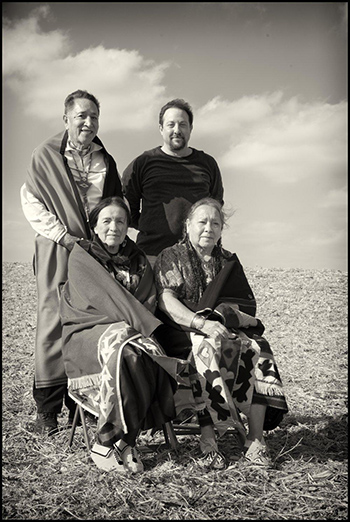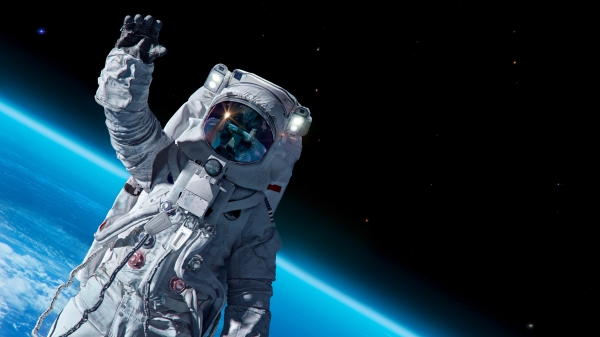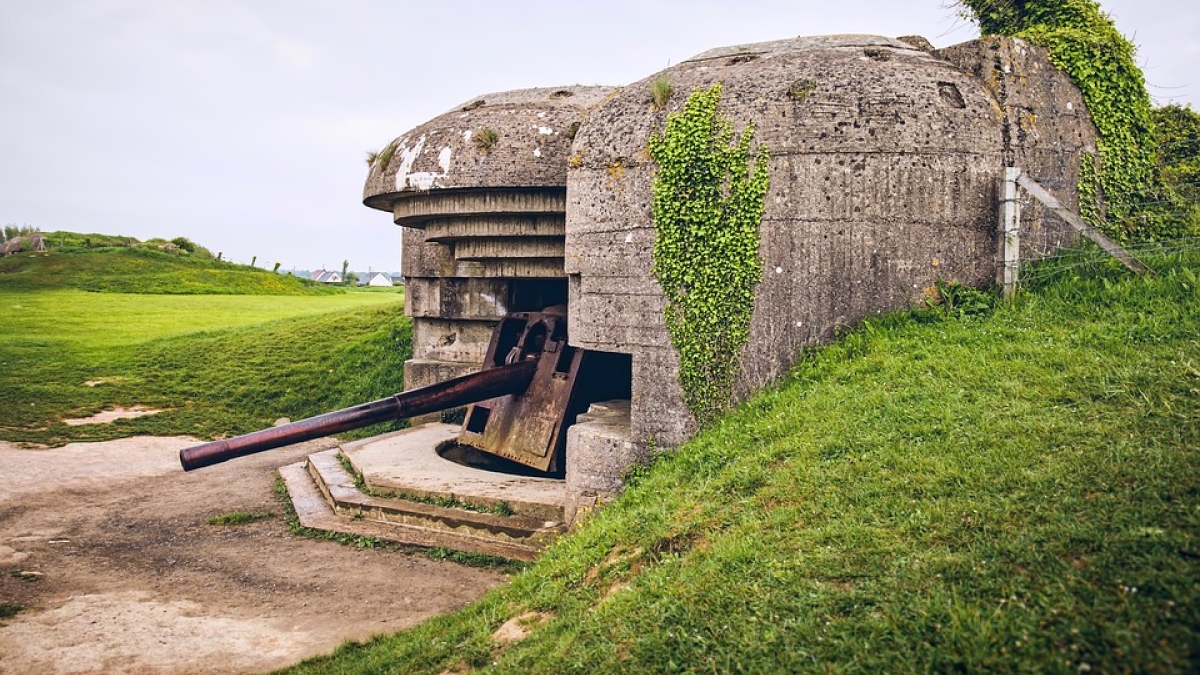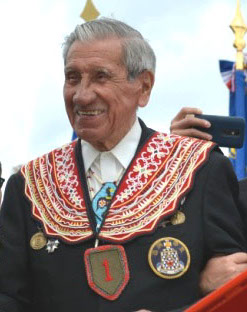It’s June 6, 1944.
Charles Norman Shay, an American Army medic and a Penobscot Indian, is among the first wave of soldiers to storm Omaha Beach in Normandy, France. German steel falls like sleet across the sand. He’s carrying a bazooka and heavy equipment. His clothes and boots are waterlogged.
"It was very difficult to make any headway," he said years after the battle. "Any headway you made was very slow. I eventually was able to get into water that only went up to my ankles … the first thing I did was head for one of the barriers that the Germans had constructed."
Shay turned to help wounded comrades struggling in the surf. He pulled one after another out of the ocean while German machine guns blazed into masses of men. His courage that day earned him a Silver Star for heroism in ground combat. Shay was one of about 175 Native Americans who fought on Omaha Beach that day. About 500 American and Canadian natives took part in the epic invasion of Fortress EuropeA propaganda term used during WWII to denote the Nazi-occupied portion of continental Europe..
Seventy-five years after D-Day, Shay will return to Omaha Beach to be recognized for his bravery and receive a Freedom Medal from French president Emmanuel Macron.
Arizona State University engineering student David Tepper will travel to France to document the historical occasion as well as continue his work photographing Native American veterans.
Tepper, a 55-year-old Navy veteran who is majoring in information technology, is also a professional photographer. He began taking pictures of Native Americans about 15 years ago and has traveled to more than 60 reservations to document their lives.
ASU Now caught up with Tepper on the eve of his departure to discuss his life, work and what he’ll be doing on the 75th anniversary of D-Day.
Charles Norman Shay
Question: Why and how long have you been documenting Native Americans, particularly veterans?
Answer: I’ve been documenting Native Americans and Native American veterans for about 15 years but I feel like I’ve been preparing for it all my life.
I was born and raised in Rome, Italy. I was born near the Jewish ghettos of WWII. During WWII, 50,000 people lived in 1 square mile. They could leave during the day to work, but had to return by nightfall. That was a form of reservation — at least it was to me. When I was young, spaghetti Westerns movies were in vogue. I watched them all. I rooted for any Native American that came across the screen. Fast forward a number of years. I participated in a photography workshop in and around the Pine Ridge Reservation in South Dakota. There were a few photographers from Italy and I became their translator. During that trip, we met some Native Americans and they had an enormous impact on me. In particular, one gentleman was taken as a child, sent to Philadelphia to attend a Catholic school. He was so gentle, and not bitter at all. Even though he never went to college, he remains one of the most well-read people I’ve ever met. It was his dignity that impressed me most. So, I kept returning to Pine Ridge, meeting more people, going to various ceremonies, sweat lodges and various cultural events.
As a veteran, the word spread that I am photographer that honors Native American veterans. I give them prints of any images we make. Through word of mouth I came to meet and photograph a number of the (Navajo) Code Talkers (and) WWII, Korean War, Vietnam and other veterans.
Q: I would assume you have had to build a level of trust over time given that what you do is such an intimate act?
A: I have been fortunate enough in my work. People respond to my work, and to my intentions. I explore, I don’t exploit. My intentions are quite simple. I make images with people that they are proud of. I sit with them, get to know them. I don’t set up any equipment such as backdrops, strobes and cameras until we know each other. Sometimes I cook for them, sometimes I bring a gift. It is impolite to ask someone to make their picture — or any favor for that matter — without giving something in return. Making a portrait is a collaborative effort. They have to trust me in order to reveal themselves to me and to the camera. Only then is a proper portrait made.
I also want to point out that I don’t use the words "shoot," "capture" or "take." Words are important, and those verbs are associated with guns. I am not making a statement against guns, just that photographers ought to have their own vocabulary.

ASU engineering student David Tepper (upper right) with Umoho tribe members Rudi Mitchell, Happy Keen and Octa Keen. Courtesy of David Tepper
Q: You have visited approximately 60 reservations over the years. What have you seen and what have you learned on these visits?
A: What a question. I have seen many things. The good, the bad and the ugly. I have seen dignity, kindness, charity, empathy and a wonderful sense of humor. I have seen drunkenness, loss of hope. I have seen gangs, abject poverty. Through all this, I have seen the resiliency of spirit. The pride in one’s own culture/heritage. I have seen that indigenous people have a sense of home. That is something that resonates with me, as I’ve never felt a sense of home as some of these friends I’ve met. I am honored to have made lifelong friends with people I’ve met on reservations. There are spiritual leaders that I admire very much. I have been to a number of ceremonies that I would never photograph. I have been to a number of sweat lodge ceremonies. They are wonderful. I have even been to a sweat with a Catholic priest. He knew all the songs and participated completely. It was a powerful experience.
I once had a video conference with a professor. He wore a “mock” baseball jersey that made fun of the Cleveland Indians. His jersey said “Caucasians.” That is the sense of humor that represents Native Americans to me.
Q: What are your thoughts and feelings regarding Native American veterans and why they join the military given the government’s history and treatment of Native Americans?
A: There are many reasons that Native Americans join the military. I do not feel qualified to answer why Native Americans join the military. What I can answer is that the Code Talkers and other WWII, Korean War, and Vietnam War Native American veterans are proud of their service. They have an air of dignity. They are quiet and humble. They know their contribution to our country. They know how to say thank you when they are honored, and without using too many words. Without fanfare. I think we can all learn that lesson.
For the second part of your question, I think it is a travesty how some people have been treated. I think the Johnny Cash song “The Ballad of Ira Hayes” says it best. Our country has many problems, and systemic racism is on the top of the list. It is my hope that in some small way my images show that no matter who we are, where we come from, how we ended up here in our country, we are all American.
Q: Tell me why you’re headed to Normandy and what you’ll be doing there?
A: I have been hired by a delegation of Native Americans — about 80 veterans from various tribes — to travel to Normandy, France, for the 75th anniversary of D-Day. The Native American veterans will also be carrying Eagle Staffs to many of the functions surrounding the 75th anniversary. Eagle Staffs are very important to Native Americans. It represents who they are. A number of these Eagle Staffs will be represented in France. Only two years ago were they allowed to be carried in the activities surrounding D-Day anniversaries. In fact, only a few years ago, Eagle Staffs were officially recognized in our country.
I am also going to France to honor a WWII veteran I have photographed. Charles Shay, WWII D-Day veteran and Penobscot Indian Elder is being presented with the Freedom Medal by French President Macron. I am honored to know him, and to be at his ceremony and make his picture.
Top photo: Abandoned German army bunker at Normandy, France. Courtesy of Pixabay.
More Science and technology

Unlocking new pathways in regenerative medicine
In the quest to advance regenerative medicine, the Harris Lab at Arizona State University is making groundbreaking strides. Focused on tissue regeneration and the intricate biology of cell death, the…

Brilliant move: Mathematician’s latest gambit is new chess AI
Benjamin Franklin wrote a book about chess. Napoleon spent his post-Waterloo years in exile playing the game on St. Helena. John Wayne carried a set and played during downtime while filming “El…

ASU team studying radiation-resistant stem cells that could protect astronauts in space
It’s 2038.A group of NASA astronauts headed for Mars on a six-month scientific mission carry with them personalized stem cell banks. The stem cells can be injected to help ward off the effects of…



